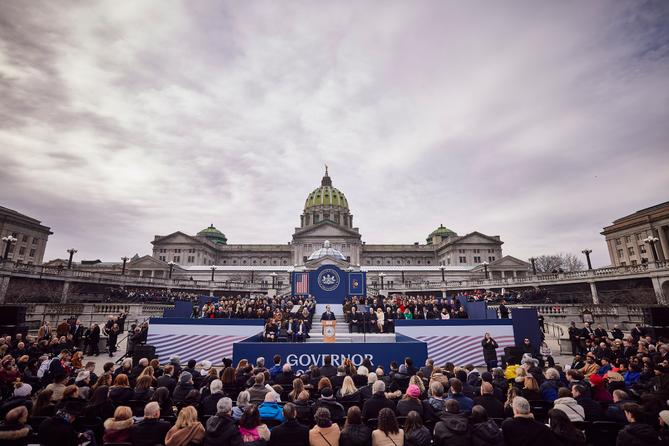HARRISBURG — Pennsylvania Gov. Josh Shapiro is staying put.
But his recent consideration in the veepstakes raised the possibility that the Democrat, whose national profile continues to rise, would not serve all of his four-year term. (Since being passed over for Minnesota Gov. Tim Walz for the vice presidential slot, Shapiro has repeatedly said he’s happy with his current job.)
If Shapiro were to move to a higher office, the process of replacing him would follow rules laid out in the Pennsylvania Constitution.
These line of succession rules don’t come up often, but they have been used once in the recent past. Read on to learn more about the protocol and how this kind of disruption has worked before.
How does the line of succession work?
State elected officials such as the governor are allowed to run for another office and keep their seat. Under the Pennsylvania Constitution, they don’t have to resign until they are sworn into a different state or federal office.
When they do resign — for that or another reason — the change sets the line of succession in motion.
In Pennsylvania, the lieutenant governor — currently Democrat Austin Davis — becomes the governor if the latter can no longer serve in the role.
This rule isn’t unusual. In all but six states, the lieutenant governor is next in line. States vary, however, in terms of how long the lieutenant governor serves as chief executive. Some install the lieutenant only until a permanent governor can be elected.
The Pennsylvania Constitution mandates that once a lieutenant governor steps in, they serve out the rest of the term.
More unusual is the way the commonwealth spells out what happens to the lieutenant governor’s office.
In many states, the new governor appoints a second-in-command. But in Pennsylvania, another official automatically moves up to fill the role: the president pro tempore of the state Senate. That rule holds even if the president pro tempore is from a different party from the lieutenant governor.
Pennsylvania’s current president pro tempore is state Sen. Kim Ward (R., Westmoreland), an outspoken conservative who has in the past clashed with Shapiro on issues like school choice and spending. Presidents pro tempore are selected in internal chamber elections.

Has a Pennsylvania governor ever stepped down early?
Yes — though it doesn’t happen often.
Near the end of his second term, Republican Gov. Tom Ridge got a call from the president to serve as head of the newly created Department of Homeland Security just after the 9/11 attacks.
Ridge resigned in October 2001, and Lt. Gov. Mark Schweiker, also a Republican, stepped up to serve out the remainder of the term, which ended in January 2003.
“We were an executive team,” Schweiker said of himself and Ridge. “All of the big policy pursuits, all of the big challenges … we were kind of tied as one. And so my depth of understanding issues and command was optimal and ready to go. And Tom was comfortable with that.”
The commonwealth’s governor and lieutenant governor aren’t always a successful pairing, Schweiker noted. In most couplings, he said, “the No. 1 and No. 2 have no rapport, have no working relationship.”
One factor that can complicate Pennsylvania's line of succession is that governors do not pick their lieutenant governors. Candidates for each major party run separately in primaries, then become a single ticket for the general election.
This can lead to odd couplings — former Gov. Tom Wolf and his first lieutenant governor, Mike Stack, are one such pair. Stack won a crowded primary in 2014 but came under scrutiny due to reports that he had mistreated his staff, souring his relationship with Wolf.
But Ridge and Schweiker were friends and allies, Schweiker said. They had a positive dynamic, and Schweiker felt involved before he even took the reins. He doesn’t see “the Shapiro-Davis model” as being an odd coupling either.
The two announced themselves as a unified ticket before the primary election, and Davis has been visible in his role, crisscrossing the state to promote the Shapiro administration’s wins.
There was one other time in the past few decades when the line of succession had to take effect, though it wasn’t because a governor departed. In November 2008, Lt. Gov. Catherine Baker Knoll, a Democrat who served under Gov. Ed Rendell of the same party, died in office. Her successor was a Republican, then-state Senate President Pro Tempore Joe Scarnati.
Scarnati was sworn in as lieutenant governor less than a month after Knoll’s death and stayed in the role until Rendell’s second term ended in 2011.
Will Pa. change the way it picks its lieutenant governor?
Maybe.
Under a proposed constitutional amendment, a gubernatorial nominee would be empowered to select their running mate, subject to the approval of their political party (for Democrats, Republicans, and Libertarians) or body (for all other candidates).
While the amendment has bipartisan support in the General Assembly, it is currently stuck in the legislative process.
Both the state House and Senate must pass identical language two sessions in a row to send a proposed amendment to voters.
The legislature was on track to send the lieutenant governor amendment to voters until 2022, when Republicans added four other constitutional proposals to the underlying bill. These included a declaration that the governing document does not protect a right to abortion and an expansion of the state’s voter ID requirements.
Democrats flipped the state House later that year, and proposed constitutional changes have ground to a halt in the divided General Assembly since.
The deadline to place an amendment on the November ballot has passed. One could appear on the 2025 primary ballot if leaders reach an agreement before the end of the legislative session in November.
Spotlight PA’s Stephen Caruso contributed reporting.
BEFORE YOU GO… If you learned something from this article, pay it forward and contribute to Spotlight PA at spotlightpa.org/donate. Spotlight PA is funded by foundations and readers like you who are committed to accountability journalism that gets results.
